Founded in 1938 and published semiannually by Sophia University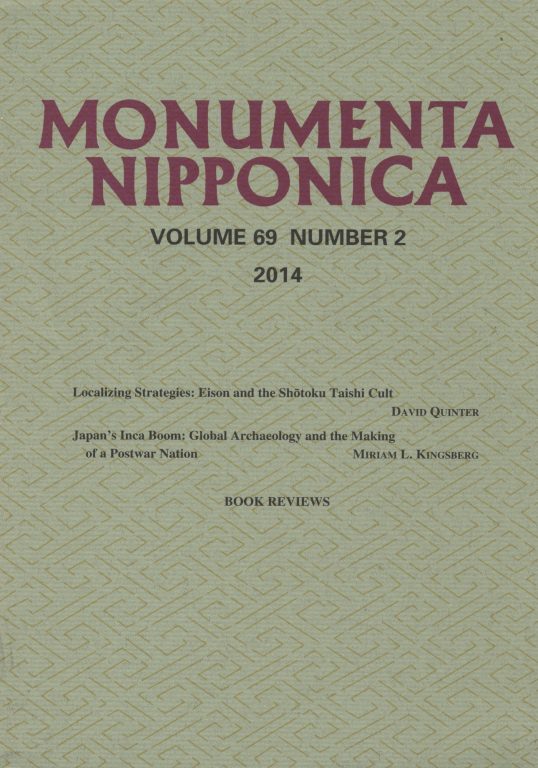 MN 69:2 (2014) 153–219Localizing Strategies: Eison and the Shōtoku Taishi CultDavid Quinter
MN 69:2 (2014) 153–219Localizing Strategies: Eison and the Shōtoku Taishi CultDavid Quinter MN 69:2 (2014) 221–54Japan’s Inca Boom: Global Archaeology and the Making of a Postwar NationMiriam L. Kingsberg Kadia
MN 69:2 (2014) 221–54Japan’s Inca Boom: Global Archaeology and the Making of a Postwar NationMiriam L. Kingsberg Kadia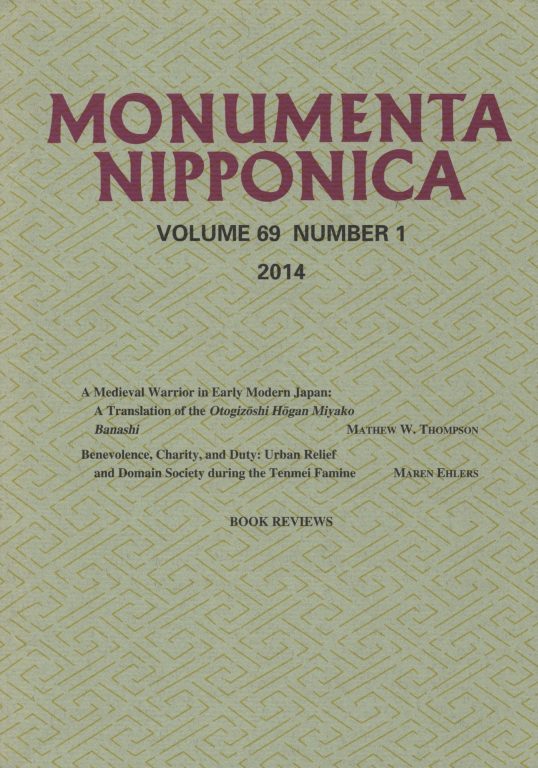 MN 69:1 (2014) 1–54A Medieval Warrior in Early Modern Japan: A Translation of the Otogizōshi Hōgan Miyako BanashiMathew W. Thompson
MN 69:1 (2014) 1–54A Medieval Warrior in Early Modern Japan: A Translation of the Otogizōshi Hōgan Miyako BanashiMathew W. Thompson MN 69:1 (2014) 55–101Benevolence, Charity, and Duty: Urban Relief and Domain Society during the Tenmei FamineMaren Ehlers
MN 69:1 (2014) 55–101Benevolence, Charity, and Duty: Urban Relief and Domain Society during the Tenmei FamineMaren Ehlers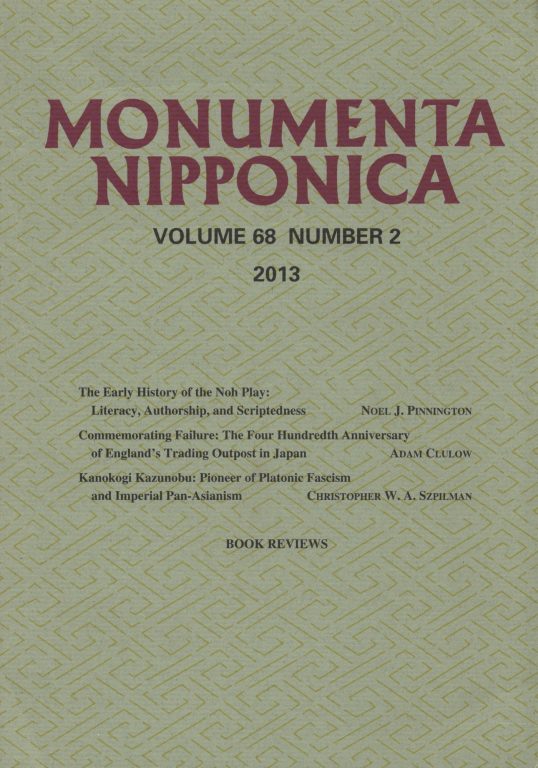 MN 68:2 (2013) 163–206The Early History of the Noh Play: Literacy, Authorship, and ScriptednessNoel John Pinnington
MN 68:2 (2013) 163–206The Early History of the Noh Play: Literacy, Authorship, and ScriptednessNoel John Pinnington MN 68:2 (2013) 207–31Commemorating Failure: The Four Hundredth Anniversary of England’s Trading Outpost in JapanAdam Clulow
MN 68:2 (2013) 207–31Commemorating Failure: The Four Hundredth Anniversary of England’s Trading Outpost in JapanAdam Clulow MN 68:2 (2013) 233–80Kanokogi Kazunobu: Pioneer of Platonic Fascism and Imperial Pan-AsianismChristopher W. A. Szpilman
MN 68:2 (2013) 233–80Kanokogi Kazunobu: Pioneer of Platonic Fascism and Imperial Pan-AsianismChristopher W. A. Szpilman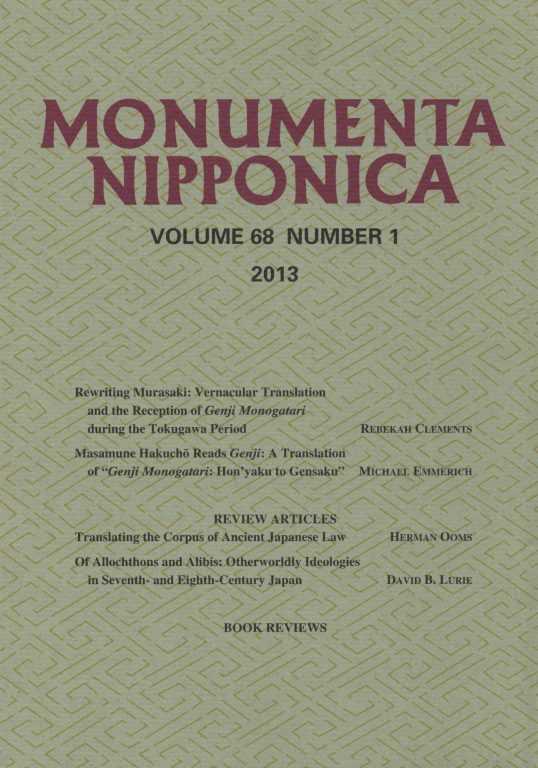 MN 68:1 (2013) 1–36Rewriting Murasaki: Vernacular Translation and the Reception of Genji Monogatari during the Tokugawa PeriodRebekah Clements
MN 68:1 (2013) 1–36Rewriting Murasaki: Vernacular Translation and the Reception of Genji Monogatari during the Tokugawa PeriodRebekah Clements MN 68:1 (2013) 37–68Masamune Hakuchō Reads Genji: A Translation of “Genji Monogatari: Hon’yaku to Gensaku”Michael Emmerich
MN 68:1 (2013) 37–68Masamune Hakuchō Reads Genji: A Translation of “Genji Monogatari: Hon’yaku to Gensaku”Michael Emmerich MN 68:1 (2013) 69–77Translating the Corpus of Ancient Japanese LawHerman Ooms
MN 68:1 (2013) 69–77Translating the Corpus of Ancient Japanese LawHerman Ooms MN 68:1 (2013) 79–88Of Allochthons and Alibis: Otherworldly Ideologies in Seventh- and Eighth-Century JapanDavid B. Lurie
MN 68:1 (2013) 79–88Of Allochthons and Alibis: Otherworldly Ideologies in Seventh- and Eighth-Century JapanDavid B. Lurie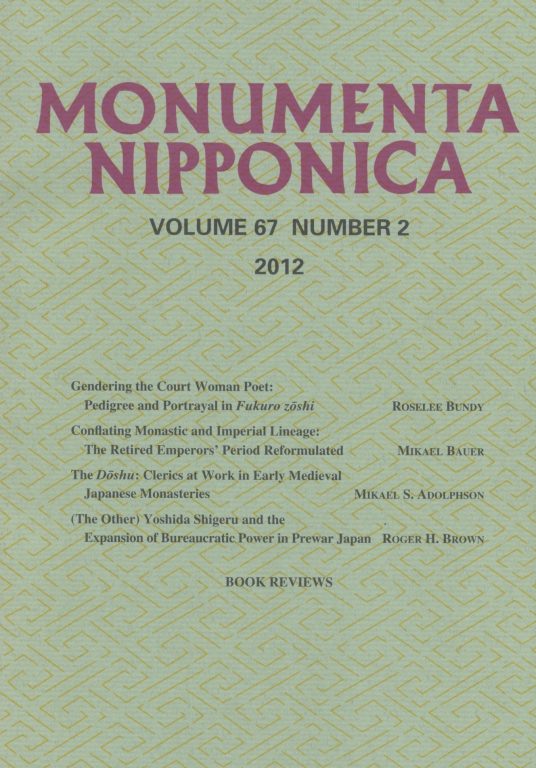 MN 67:2 (2012) 201–38Gendering the Court Woman Poet: Pedigree and Portrayal in Fukuro zōshiRoselee Bundy
MN 67:2 (2012) 201–38Gendering the Court Woman Poet: Pedigree and Portrayal in Fukuro zōshiRoselee Bundy MN 67:2 (2012) 239–62Conflating Monastic and Imperial Lineage: The Retired Emperors’ Period ReformulatedMikael Bauer
MN 67:2 (2012) 239–62Conflating Monastic and Imperial Lineage: The Retired Emperors’ Period ReformulatedMikael Bauer MN 67:2 (2012) 263–82The Dōshu: Clerics at Work in Early Medieval Japanese MonasteriesMikael S. Adolphson
MN 67:2 (2012) 263–82The Dōshu: Clerics at Work in Early Medieval Japanese MonasteriesMikael S. Adolphson MN 67:2 (2012) 283–327(The Other) Yoshida Shigeru and the Expansion of Bureaucratic Power in Prewar JapanRoger H. Brown
MN 67:2 (2012) 283–327(The Other) Yoshida Shigeru and the Expansion of Bureaucratic Power in Prewar JapanRoger H. Brown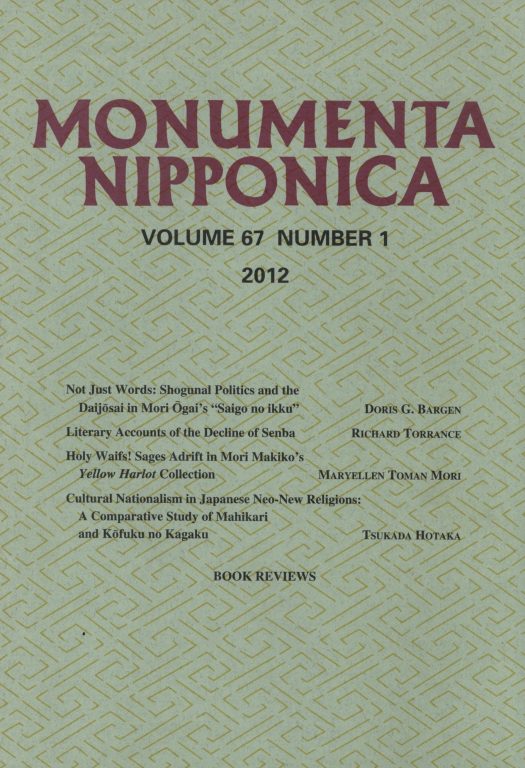 MN 67:1 (2012) 1–27Not Just Words: Shogunal Politics and the Daijōsai in Mori Ōgai’s “Saigo no ikku”Doris G. Bargen
MN 67:1 (2012) 1–27Not Just Words: Shogunal Politics and the Daijōsai in Mori Ōgai’s “Saigo no ikku”Doris G. Bargen MN 67:1 (2012) 29–73Literary Accounts of the Decline of SenbaRichard Torrance
MN 67:1 (2012) 29–73Literary Accounts of the Decline of SenbaRichard Torrance MN 67:1 (2012) 75–131Holy Waifs! Sages Adrift in Mori Makiko’s Yellow Harlot CollectionMaryellen Toman Mori
MN 67:1 (2012) 75–131Holy Waifs! Sages Adrift in Mori Makiko’s Yellow Harlot CollectionMaryellen Toman Mori MN 67:1 (2012) 133–57Cultural Nationalism in Japanese Neo-New Religions: A Comparative Study of Mahikari and Kōfuku no KagakuHotaka Tsukada and Gaynor Sekimori
MN 67:1 (2012) 133–57Cultural Nationalism in Japanese Neo-New Religions: A Comparative Study of Mahikari and Kōfuku no KagakuHotaka Tsukada and Gaynor Sekimori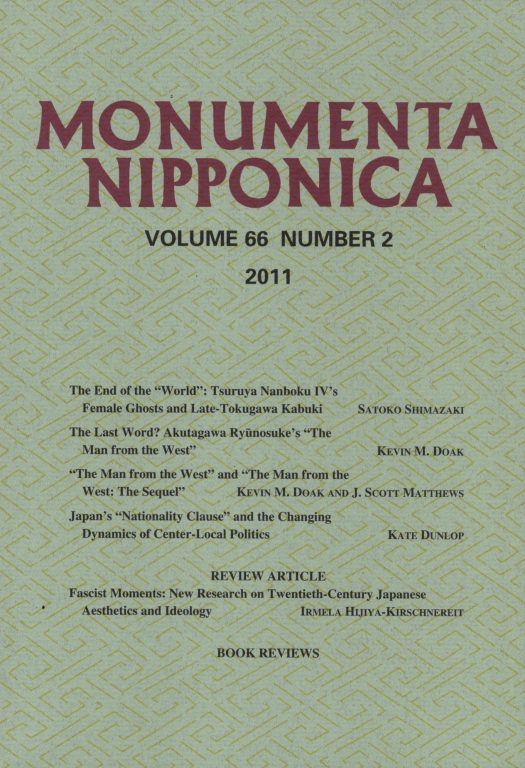 MN 66:2 (2011) 209–46The End of the “World”: Tsuruya Nanboku IV’s Female Ghosts and Late-Tokugawa KabukiSatoko Shimazaki
MN 66:2 (2011) 209–46The End of the “World”: Tsuruya Nanboku IV’s Female Ghosts and Late-Tokugawa KabukiSatoko Shimazaki MN 66:2 (2011) 247–80The Last Word?: Akutagawa Ryūnosuke’s “The Man from the West”Kevin M. Doak
MN 66:2 (2011) 247–80The Last Word?: Akutagawa Ryūnosuke’s “The Man from the West”Kevin M. Doak MN 66:2 (2011) 281–318Japan’s “Nationality Clause” and the Changing Dynamics of Center-Local PoliticsKate Dunlop
MN 66:2 (2011) 281–318Japan’s “Nationality Clause” and the Changing Dynamics of Center-Local PoliticsKate Dunlop MN 66:2 (2011) 319–33Fascist Moments: New Research on Twentieth-Century Japanese Aesthetics and IdeologyIrmela Hijiya-Kirschnereit
MN 66:2 (2011) 319–33Fascist Moments: New Research on Twentieth-Century Japanese Aesthetics and IdeologyIrmela Hijiya-Kirschnereit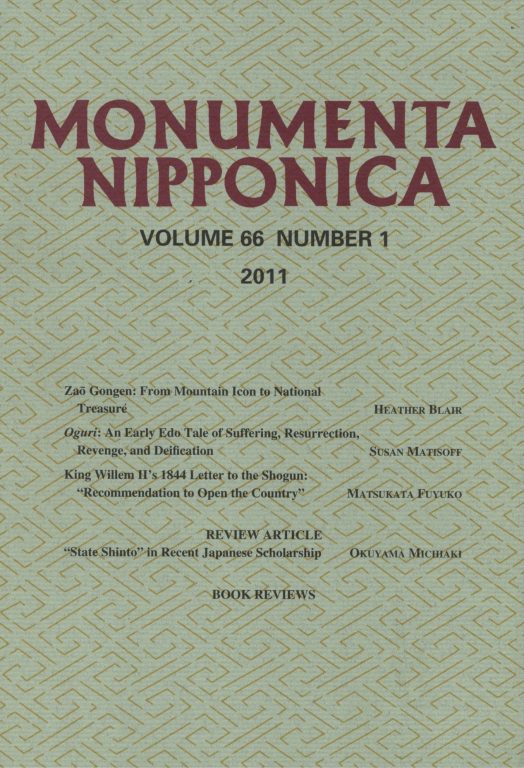 MN 66:1 (2011) 1–47Zaō Gongen: From Mountain Icon to National TreasureHeather Blair
MN 66:1 (2011) 1–47Zaō Gongen: From Mountain Icon to National TreasureHeather Blair MN 66:1 (2011) 49–97Oguri: An Early Edo Tale of Suffering, Resurrection, Revenge, and DeificationSusan Matisoff
MN 66:1 (2011) 49–97Oguri: An Early Edo Tale of Suffering, Resurrection, Revenge, and DeificationSusan Matisoff MN 66:1 (2011) 99–122King Willem II’s 1844 Letter to the Shogun: “Recommendation to Open the Country”Adam Clulow and Fuyuko Matsukata
MN 66:1 (2011) 99–122King Willem II’s 1844 Letter to the Shogun: “Recommendation to Open the Country”Adam Clulow and Fuyuko Matsukata MN 66:1 (2011) 123–45“State Shinto” in Recent Japanese ScholarshipMichiaki Okuyama
MN 66:1 (2011) 123–45“State Shinto” in Recent Japanese ScholarshipMichiaki Okuyama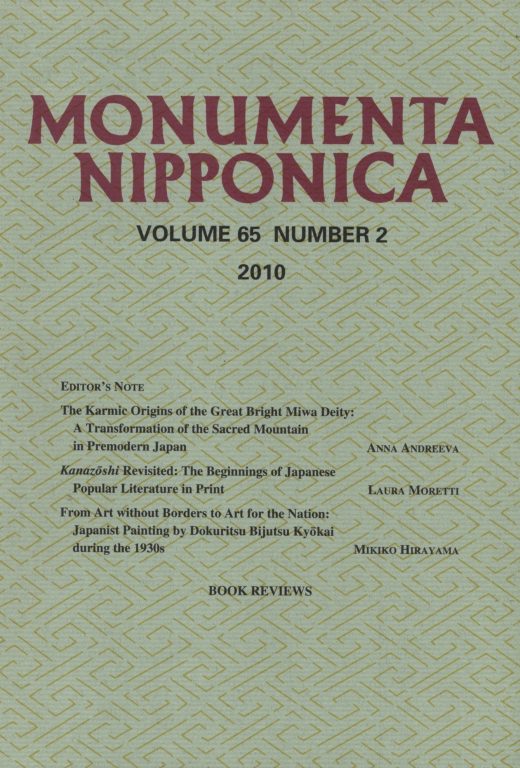 MN 65:2 (2010) 245–96The Karmic Origins of the Great Bright Miwa Deity: A Transformation of the Sacred Mountain in Premodern JapanAnna Andreeva
MN 65:2 (2010) 245–96The Karmic Origins of the Great Bright Miwa Deity: A Transformation of the Sacred Mountain in Premodern JapanAnna Andreeva MN 65:2 (2010) 297–356Kanazōshi Revisited: The Beginnings of Japanese Popular Literature in PrintLaura Moretti
MN 65:2 (2010) 297–356Kanazōshi Revisited: The Beginnings of Japanese Popular Literature in PrintLaura Moretti MN 65:2 (2010) 357–95From Art without Borders to Art for the Nation: Japanist Painting by Dokuritsu Bijutsu Kyōkai during the 1930s (Images)Mikiko Hirayama
MN 65:2 (2010) 357–95From Art without Borders to Art for the Nation: Japanist Painting by Dokuritsu Bijutsu Kyōkai during the 1930s (Images)Mikiko Hirayama MN 65:2 (2010) 357–95From Art without Borders to Art for the Nation: Japanist Painting by Dokuritsu Bijutsu Kyōkai during the 1930sMikiko Hirayama
MN 65:2 (2010) 357–95From Art without Borders to Art for the Nation: Japanist Painting by Dokuritsu Bijutsu Kyōkai during the 1930sMikiko Hirayama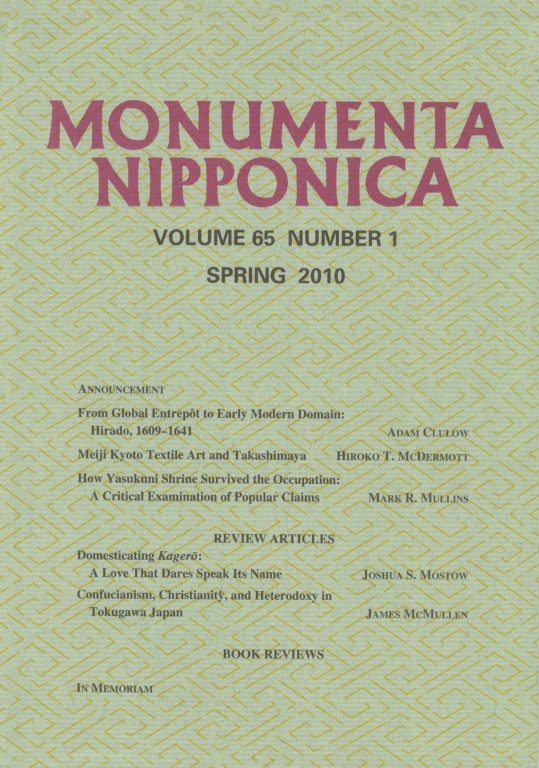 MN 65:1 (2010) 1–35From Global Entrepôt to Early Modern Domain: Hirado, 1609–1641Adam Clulow
MN 65:1 (2010) 1–35From Global Entrepôt to Early Modern Domain: Hirado, 1609–1641Adam Clulow MN 65:1 (2010) 37–88Meiji Kyoto Textile Art and TakashimayaHiroko T. McDermott
MN 65:1 (2010) 37–88Meiji Kyoto Textile Art and TakashimayaHiroko T. McDermott MN 65:1 (2010) 89–136How Yasukuni Shrine Survived the Occupation: A Critical Examination of Popular ClaimsMark R. Mullins
MN 65:1 (2010) 89–136How Yasukuni Shrine Survived the Occupation: A Critical Examination of Popular ClaimsMark R. Mullins MN 65:1 (2010) 137–47Domesticating Kagerō: A Love That Dares Speak Its NameJoshua S. Mostow
MN 65:1 (2010) 137–47Domesticating Kagerō: A Love That Dares Speak Its NameJoshua S. Mostow MN 65:1 (2010) 149–95Confucianism, Christianity, and Heterodoxy in Tokugawa JapanJames McMullen
MN 65:1 (2010) 149–95Confucianism, Christianity, and Heterodoxy in Tokugawa JapanJames McMullen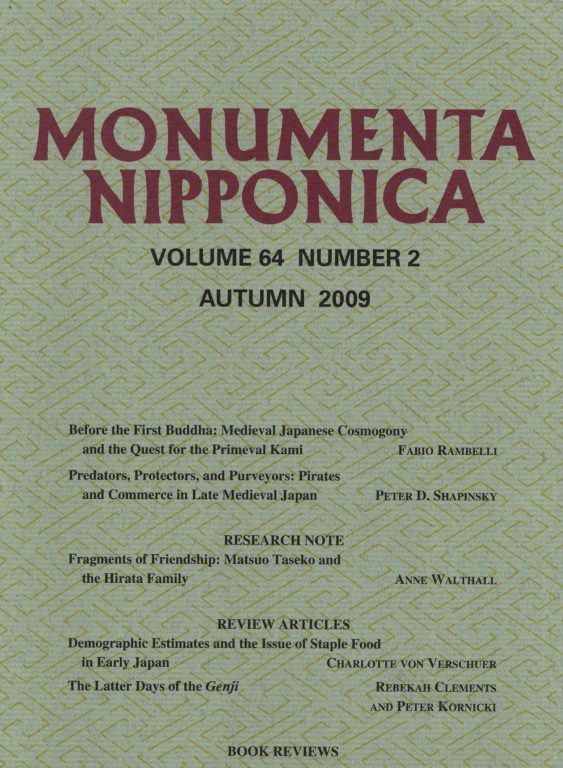 MN 64:2 (2009) 235–71Before the First Buddha: Medieval Japanese Cosmogony and the Quest for the Primeval KamiFabio Rambelli
MN 64:2 (2009) 235–71Before the First Buddha: Medieval Japanese Cosmogony and the Quest for the Primeval KamiFabio Rambelli MN 64:2 (2009) 273–313Predators, Protectors, and Purveyors: Pirates and Commerce in Late Medieval JapanPeter D. Shapinsky
MN 64:2 (2009) 273–313Predators, Protectors, and Purveyors: Pirates and Commerce in Late Medieval JapanPeter D. Shapinsky MN 64:2 (2009) 315–35Fragments of Friendship: Matsuo Taseko and the Hirata FamilyAnne Walthall
MN 64:2 (2009) 315–35Fragments of Friendship: Matsuo Taseko and the Hirata FamilyAnne Walthall MN 64:2 (2009) 337–62Demographic Estimates and the Issue of Staple Food in Early JapanCharlotte von Verschuer
MN 64:2 (2009) 337–62Demographic Estimates and the Issue of Staple Food in Early JapanCharlotte von Verschuer MN 64:2 (2009) 363–72The Latter Days of the GenjiRebekah Clements and Peter F. Kornicki
MN 64:2 (2009) 363–72The Latter Days of the GenjiRebekah Clements and Peter F. Kornicki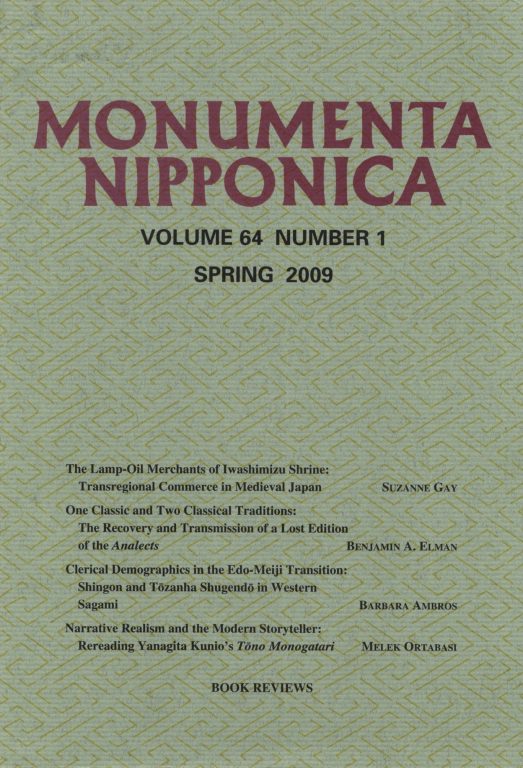 MN 64:1 (2009) 1–52The Lamp-Oil Merchants of Iwashimizu Shrine: Transregional Commerce in Medieval JapanSuzanne Gay
MN 64:1 (2009) 1–52The Lamp-Oil Merchants of Iwashimizu Shrine: Transregional Commerce in Medieval JapanSuzanne Gay MN 64:1 (2009) 53–82One Classic and Two Classical Traditions: The Recovery and Transmission of a Lost Edition of the AnalectsBenjamin A. Elman
MN 64:1 (2009) 53–82One Classic and Two Classical Traditions: The Recovery and Transmission of a Lost Edition of the AnalectsBenjamin A. Elman MN 64:1 (2009) 83–125Clerical Demographics in the Edo-Meiji Transition: Shingon and Tōzanha Shugendō in Western SagamiBarbara Ambros
MN 64:1 (2009) 83–125Clerical Demographics in the Edo-Meiji Transition: Shingon and Tōzanha Shugendō in Western SagamiBarbara Ambros MN 64:1 (2009) 127–66Narrative Realism and the Modern Storyteller: Rereading Yanagita Kunio’s Tōno MonogatariMelek Ortabasi
MN 64:1 (2009) 127–66Narrative Realism and the Modern Storyteller: Rereading Yanagita Kunio’s Tōno MonogatariMelek Ortabasi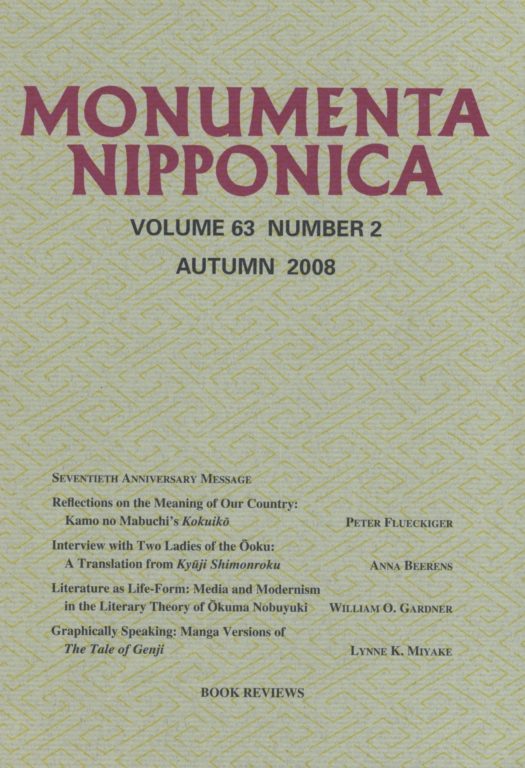 MN 63:2 (2008) 211–38Reflections on the Meaning of Our Country: Kamo no Mabuchi’s KokuikōPeter Flueckiger
MN 63:2 (2008) 211–38Reflections on the Meaning of Our Country: Kamo no Mabuchi’s KokuikōPeter Flueckiger MN 63:2 (2008) 265–81Interview with Two Ladies of the Ōoku: A Translation from Kyūji ShimonrokuAnna Beerens
MN 63:2 (2008) 265–81Interview with Two Ladies of the Ōoku: A Translation from Kyūji ShimonrokuAnna Beerens MN 63:2 (2008) 325–57Literature as Life-Form: Media and Modernism in the Literary Theory of Ōkuma NobuyukiWilliam O. Gardner
MN 63:2 (2008) 325–57Literature as Life-Form: Media and Modernism in the Literary Theory of Ōkuma NobuyukiWilliam O. Gardner












